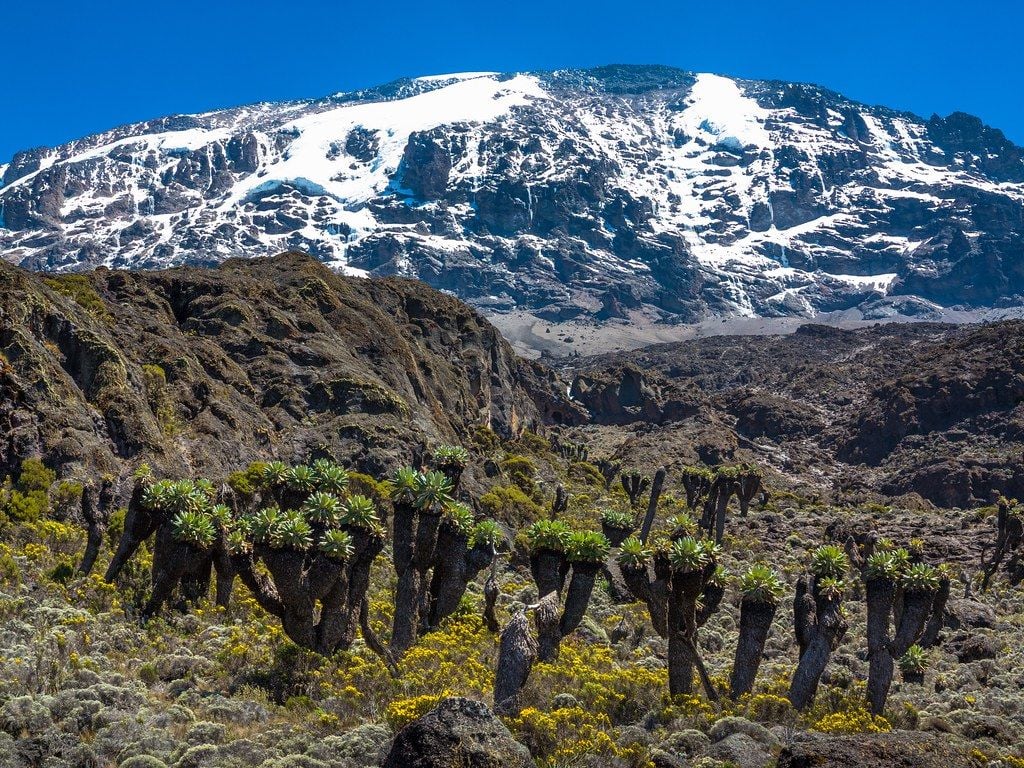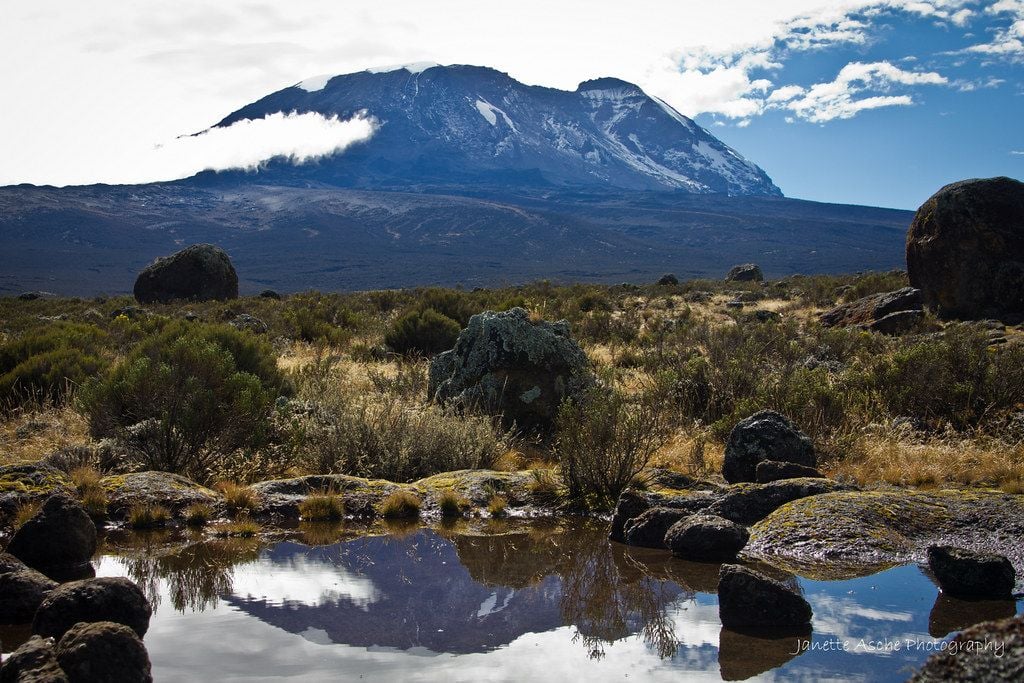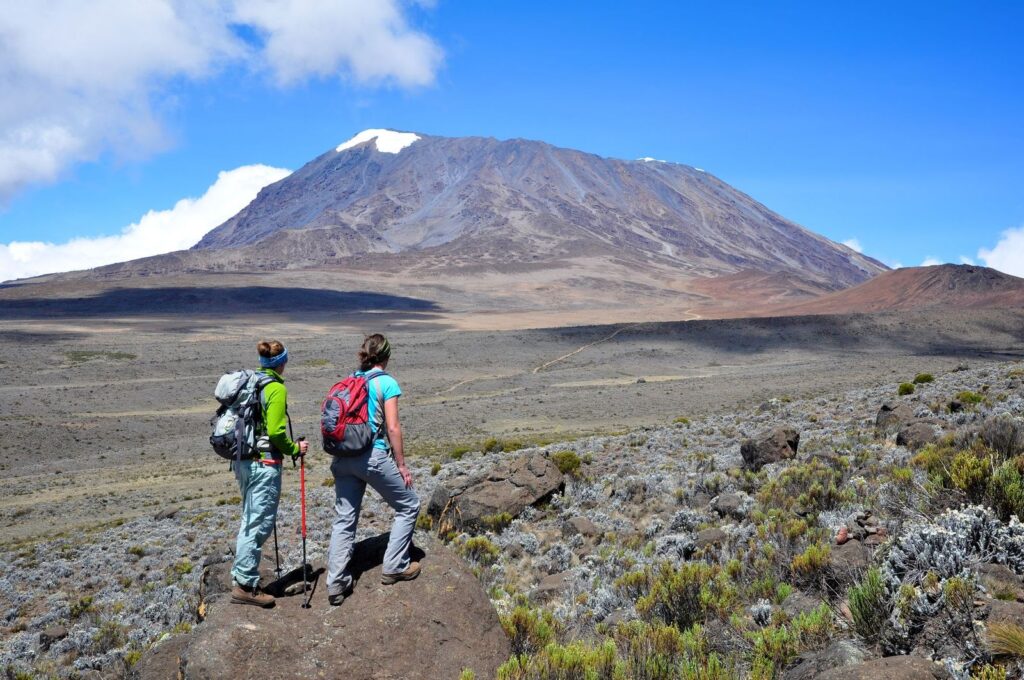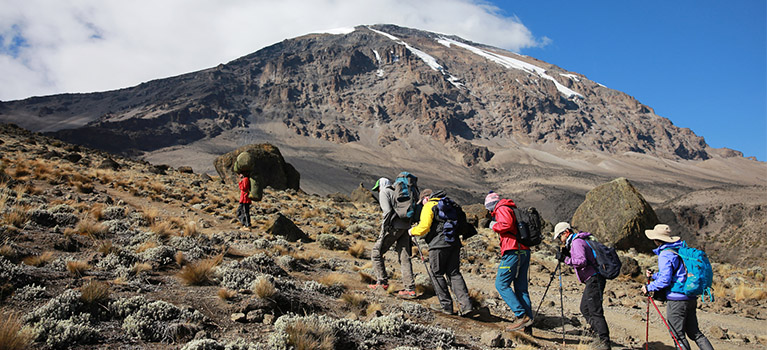
CLIMBING MOUNT KILIMANJARO
Mount Kilimanjaro Climbing 2025. At 5,895 meters (19,341 feet) Mount Kilimanjaro is the highest mountain in Africa and the tallest freestanding mountain in the world; it is one of the Seven Summits. The snow-capped peak of Africa is a dormant volcano and can be found inside the Kilimanjaro National Park of Tanzania.
Dominating the landscape like no other mountain, iconic and instantly recognizable, Kilimanjaro in Tanzania is the highest peak in Africa and the world’s tallest freestanding mountain at 5895 metres. To climb Kilimanjaro is a great challenge and entirely feasible for the active traveler or keen walker looking for something new. In a matter of days, you’ll climb Kilimanjaro from the hot plains of Africa through grasslands, tropical rain forest, alpine meadows, moorlands and desert uplands onto snow and ice.
As one of the premier Mount Kilimanjaro tour operators, we have regular climbs on four of the main routes:
- Trekking Mount Kilimanjaro via the Machame route in 7 days is our preferred route as it offers excellent acclimatization and views.
- The Lemosho route, is the same as the Machame route after the second camp (Shira Plateau) but gives an extra day on the mountain.
- Or there is one which approaches from the north of the mountain and is a less travelled option. It’s also good during the rainy season as it’s more sheltered.
- Or for those who have a bit of time we also have climbs via the 9-day Northern Circuit route.
Where is Mount Kilimanjaro?
Kilimanjaro is located in the northeast of Tanzania, near the Kenyan border. It lies around 140 kilometres south of Nairobi (the Kenyan capital), and 500 kilometres northeast of Dodoma, Tanzania’s capital.
How Do I Get to Mount Kilimanjaro?
To get to Kilimanjaro you need to fly to Kilimanjaro International Airport (KIA). There are several direct flights from Europe (from Amsterdam and Zurich) and the Middle East (Doha and Turkey). But chances are you’ll need to fly via another African destination – Dar es Salaam, Addis Ababa and Nairobi are your best bet.
A Mount Kilimanjaro hike will typically set off from one of two towns: Arusha, to the south west of the mountain, and Moshi, directly south. It takes around an hour to reach Moshi and 80 minutes to reach Arusha. The most common method of transportation is via taxi or prebooked shuttle – in many cases, however, your tour operator will meet you at the airport.
When is the Best Time to Climb Kilimanjaro?
Mount Kilimanjaro sits in Kilimanjaro National Park. It’s 300km south of the equator – and Tanzania is iconically tropical, with wet seasons and and dry season variations laid over a hot muggy climate. So when is the best time to climb Kilimanjaro? Let’s take a look at the seasons and Kilimanjaro climbing season.
Tanzania experiences two rainy seasons: a short one in November to mid-December and the long rainy season from March to May. The routes on Mount Kilimanjaro can be wet and muddy underfoot during these seasons. If you care less about monsoonal weather and more about solitude, then you may prefer these times to climb as there are far fewer people. Although expect to get very damp.
July to October is peak time on the mountain, especially as it coincides with European summer holidays. This window of time is dry and cooler than the Christmas months, but prepare for some cold nights. If you want to enjoy similar weather, but with far fewer people, then Mid-May to June is an optimal time for you. It’s just before the holidays, but still peak climbing season.
December to February are much warmer and have good visibility. The short rainy season can run into December though so it may still be wet. These months also coincide with the Christmas holidays so it can still get busy.

How Long Does it Take to Climb Kilimanjaro?
There are seven routes up Kilimanjaro, each of which takes between five and nine days. However, it’s very important not to rush the ascent as it could lower your success rate! The reason for this is because you need to ensure time for your body to acclimate to high altitude.
A slow, steady ascent gives your body time to adjust to high altitudes – where there is less oxygen in the air – if you race to the summit, you’re in danger of getting altitude sickness and having to leave the mountain.
Is it Difficult to Climb Mount Kilimanjaro?
Climbing Kilimanjaro is no small undertaking. It may be considered one of the easiest of the Seven Summits, but it’s still a 5,895m mountain. Porters will be on hand to carry some of your kit, but you’ll still be wearing a daypack containing all the food, water and clothing you need for the day.
You can skip acclimatization days and make very quick ascents on Kilimanjaro. But this is definitely not recommended. Altitude sickness is no joke on the mountain.
Can You Climb Kilimanjaro Without a Guide?
In 1991, the Tanzanian government and Kilimanjaro National Park passed a regulation that all trekkers must be accompanied by a registered and licensed guide. Trekkers need to register with the Parks Authority before setting out, and sign in at each camp – they are forbidden from wild camping or using caves for shelter. Rangers on the mountains will ensure that these rules are enforced.
You’ll also need to pay park entrance fees to climb Kilimanjaro. These might seem hefty, but they include a conservation fee – to help cover the cost of maintenance – campsite fees, and even a rescue fee (just in case). You can expect to pay around £600-£800 in park fees, depending on the duration of your trek. This needs to be provided to the park authorities in advance through your tour operator, rather than independently.
How Much Does it Cost to Climb Kilimanjaro?
Undeniably, Kilimanjaro treks can be expensive. Not only are there the national park fees, but you’ll also have to pay for your guide. Many tour operators use porters to help carry heavy camping equipment, as well as other support staff.
Climbing Kilimanjaro often costs between £1500 and £4500, depending on the length of your route and the tour operator you use. We wouldn’t recommend going for the cheapest option you can find when searching for trekking guides – you pay for experience and this means doing things properly. Decent guides will ensure proper equipment, experience in weather and trekking conditions, good food, and a good time frame to allow for rest and adjustment.
How to Prepare for Climbing Kilimanjaro
We would sincerely recommend you prepare adequately for your expedition. Plan and execute a training programme that will help improve your fitness, strength and endurance. Consider climbing a few smaller mountains in the run up to the expedition. If you live in a city, you can hit up the local gym – the stairmaster will help build endurance and strength.
If you’re going to be carrying most of your own gear, then practice hiking while carrying a weighted backpack – it really does make it much more difficult!

Need?
Although Kilimanjaro is considered a ‘walk-up mountain’, don’t be fooled into thinking it’s easy. Preparation is key, especially if you are on a shorter time frame or harder route. Porters can carry the food and cooking implements as well as your sleep system. Most trekking companies have plenty of spare equipment if you are in need, but as always, tried and tested personal gear is priceless. Pack as you would for any long multi-day treks at altitude, including the following:
- Good waterproof and breathable hiking boots and plenty of thick socks. These should be tried and tested before the hike begins as finding out they are unsuitable and uncomfortable two days in is the last thing you want.
- A good waterproof backpack and hydration sack – one big enough to hold your personal items (camera, head torch, clothes and the food you are given for the day).
- Thermals for the cold nights (and some days) hiking.
- Waterproof/windproof pants and shell, even if you are hiking in the dryer seasons – the weather can become cold very quickly.
- Quick-dry hiking clothes and trousers. Zip-off trousers are great for the first and last days of the treks.
- Fleece/down jackets are needed for when the temperature drops. It’s easy to forget these items whilst sweating at the base of the mountain in a tropical country. The summit can be as cold as -30 degrees Celsius.
- Beanie and gloves.
- Sunscreen and sunglasses is one most people forget. You can be very exposed some days and you don’t want to be burnt for your time on the mountain.
- A warm change of clothes for the nights is a great idea. They help you stay cosy and break up the amount of time you need to spend in your trekking clothes.
- As with any trek, bring basic toiletries like toothbrush and toothpaste, but not so much that you struggle to carry the weight you’ve packed.
- A head torch for the evenings and summit night.
- Hiking snacks and lots of them! Energy bars are a lightweight, high-calorie option.
- A small medical kit with essentials like plasters and second skin can be very handy. Blisters are the last thing you need!
There are seven main routes up to choose from. The particular route you choose will largely depend on your level of experience, fitness, budget and time frame – as well as your personal wants. It’s well worth looking at each of them to pick the best way to climb Kilimanjaro for you.
Mount Kilimanjaro Climbing Routes
1. Marangu Route (70km / 5-6 Days)
Considered the easiest route up Kilimanjaro, it’s also the busiest. It’s the only route up Kilimanjaro with accommodation – dormitory style beds in rustic huts. It has a lower success rate though, as it can be more difficult to acclimatise to the altitude on this route.
Contrasts on Kilimanjaro – passing through the ecosystems of the mountain on the Machame route. Photo: Getty.
2. Machame Route (61km / 6-7 Days)
A tougher climb than Marangu, Machame is known for being one of the most scenic routes. You descend on a different path to the ascent, giving you a great diversity of scenery. Good acclimatisation options; higher altitude days with lower altitude camps. One of our recommended routes.
3. Lemosho Route (67km / 7-8 Days)
Lemosho was created as an alternative Mount Kilimanjaro hike to the Shira Route, with a much better success rate. It’s more scenic and starts at a lower altitude. Less crowded than Machame and Marangu, but it takes longer to drive to the start point. One of our recommended routes.
4. Rongai Route (74km / 6-7 Days)
The only approach from the north – you’ll see less rainfall. Gentle ascent, in a more remote area. This improves your chance of seeing wildlife, but makes for a longer drive to the start point. Rongai is one of our recommended routes.
5. Shira Route (58km / 6-8 Days)
Shira starts at 3,600 metres, increasing your chance of altitude sickness. Links up with Machame on day 3. More expensive than Machame and Marangu (due to a more remote start point) and has largely been replaced by the Lemosho Route.

6. Northern Circuit (88km / 8-9 Days)
The Northern Circuit begins along the Lemosho Route, crosses the Shira plateau and then circles around the northern slopes rather than the busier eastern approach. It’s very scenic, but due to its length is the most expensive option.
7. Umbwe Route (48km / 6-7 Days)
Umbwe is considered the shortest, steepest and most difficult route by many. This is a serious Kilimanjaro mountain climb. The first day involves some very steep hiking. It has one of the lowest success rates.
Mount Kilimanjaro Climbing 2025

